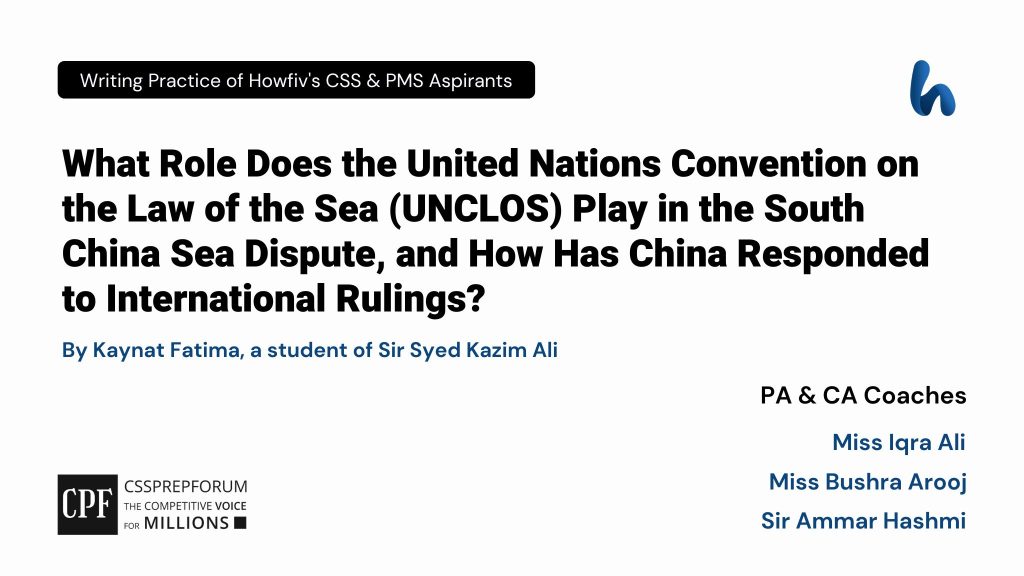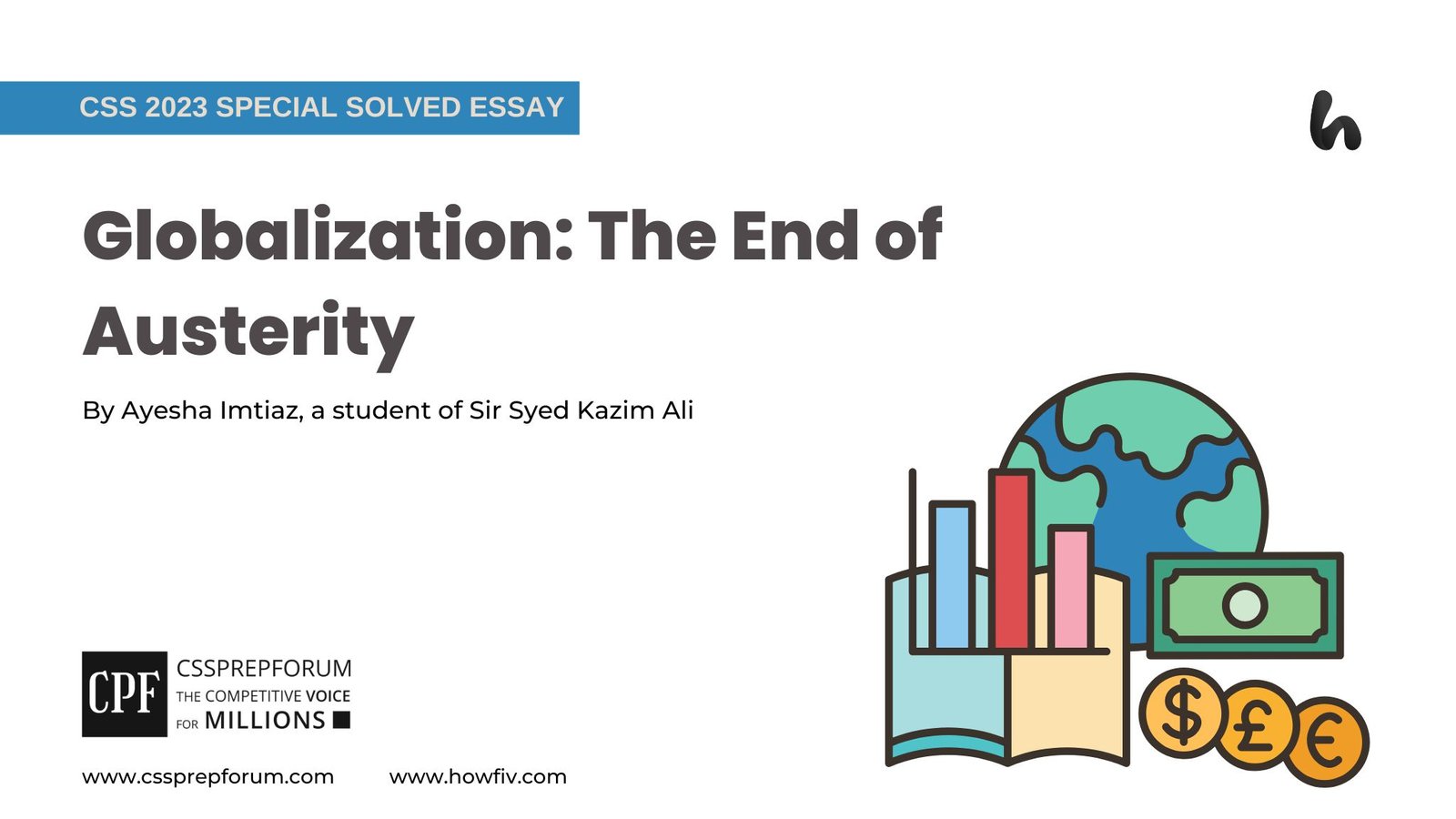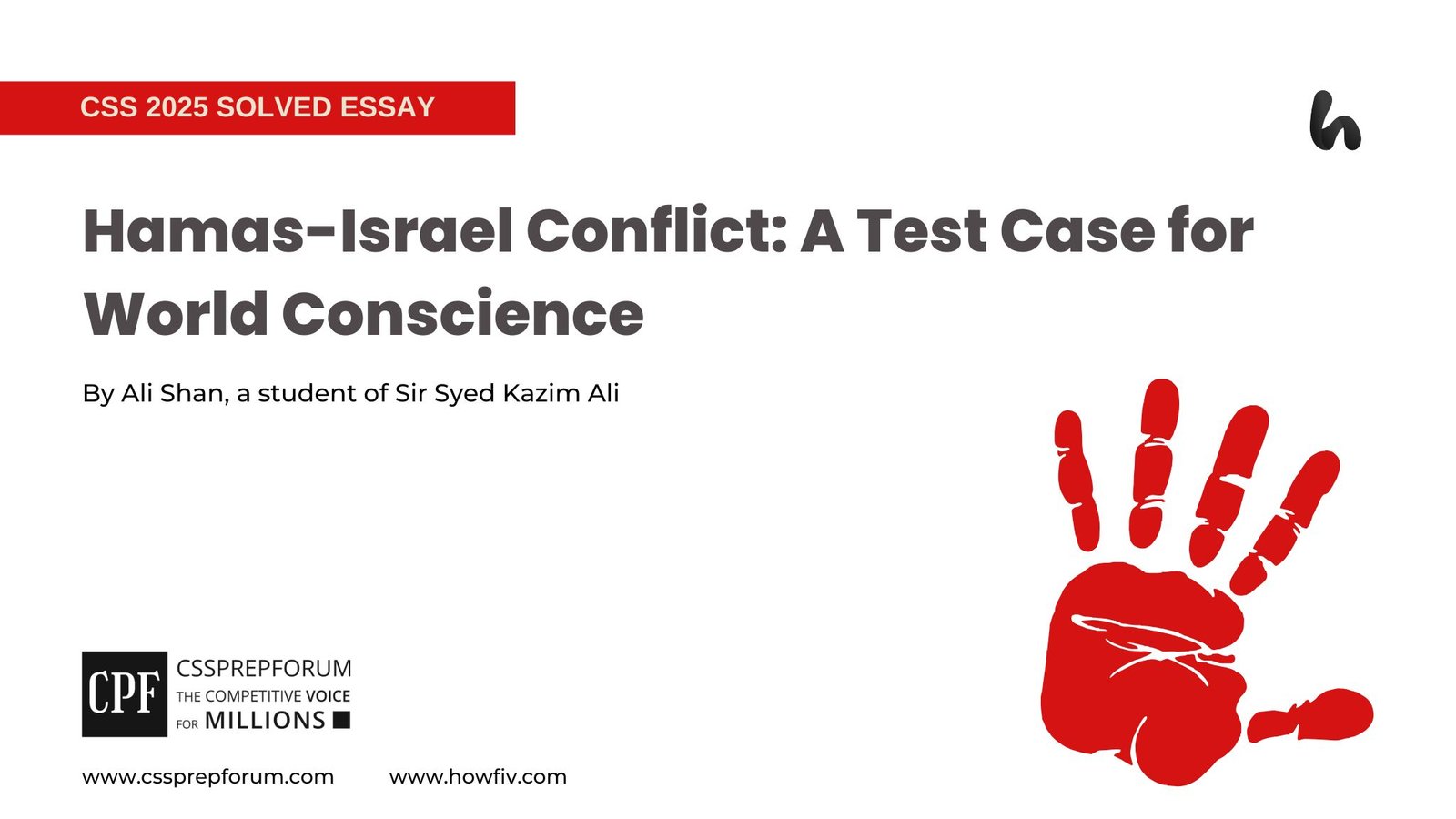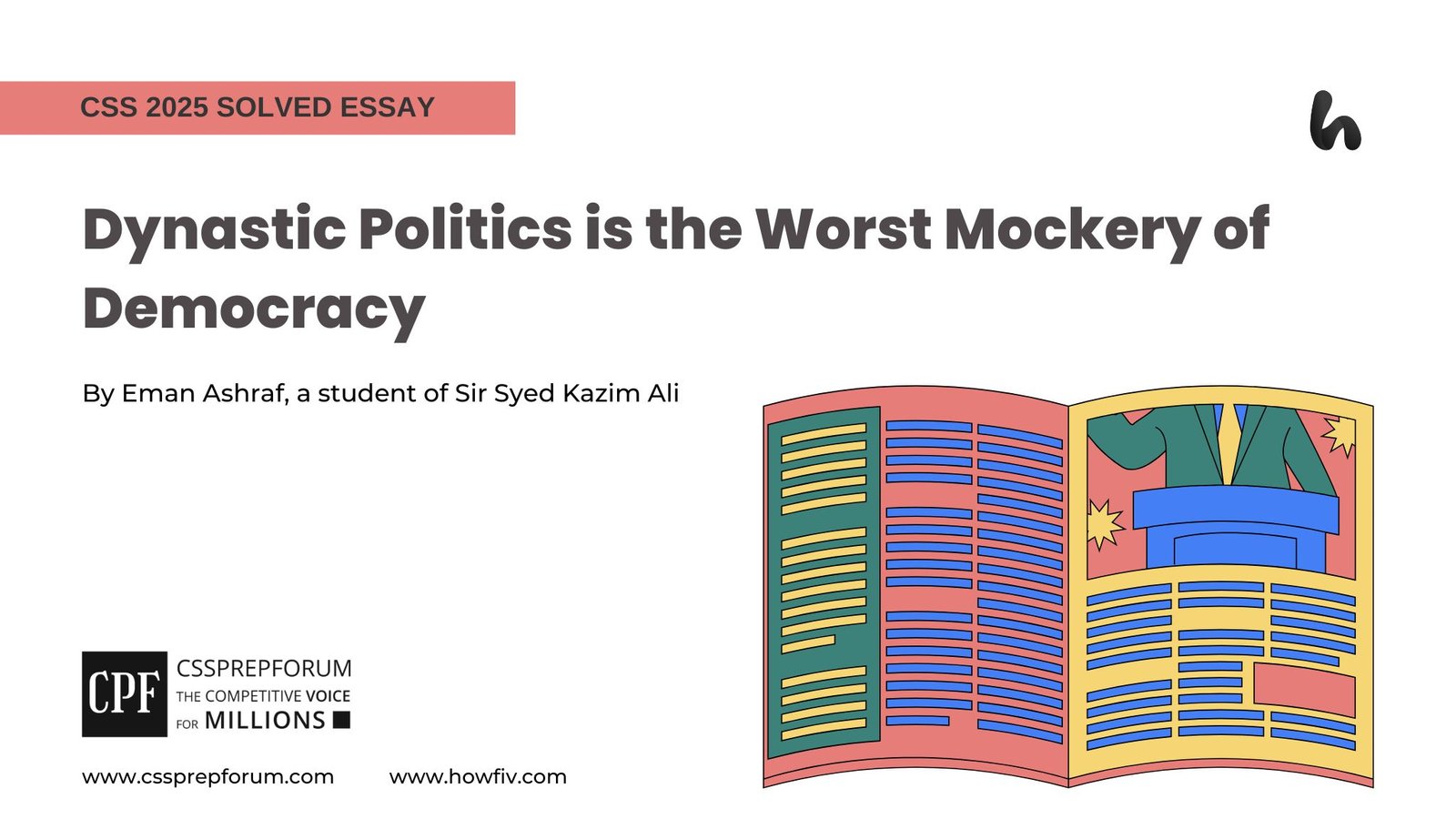CSS Current Affairs | Role of UNCLOS in the South China Sea Dispute
The following question of CSS Current Affairs is solved by Kaynat Fatima under the supervision of Howfiv’s Pakistan Affairs and Current Affairs Coaches. She learnt how to attempt 20 marks question and essay writing from Sir Syed Kazim Ali, Pakistan’s best CSS and PMS English essay and precis teacher with the highest success rate of his students. This solved past paper question is attempted on the pattern taught by Sir to his students, scoring the highest marks in compulsory and optional subjects for years, and uploaded to help aspirants understand how to crack a topic or question, how to write relevantly, what coherence is, and how to include and connect ideas, opinions, and suggestions to score the maximum.

Outline
1- Introduction
2- Understand the South China Sea dispute
3- Role of the United Nations Convention on the Law of the Sea (UNCLOS) in the South China Sea dispute
- ✓ Legislative framework for maritime claims
- Evidence: Territory sea from the baseline, a maximum of 12 nautical miles (22 kilometers; 14 miles) are allowed, and exclusive economic zones stretch out from the baseline by 200 nmi (370 km; 230 mi).
- ✓ Dispute resolution procedures: encouraging peaceful resolution of disputes
- Evidence: The arbitral panel that heard the Philippines’ South China Sea dispute against China returned a majority decision favoring the Philippines.
- ✓ Preservation of the maritime ecosystem and free navigation
- Evidence: Special provisions for the conservation of the maritime environment are found in UNCLOS Part XII.
4- China responded to international rulings
- ✓ Rejecting the decision
- Evidence: Rejecting rulings because UNCLOS declares that China’s claims based on the nine-dash line are unlawful.
- ✓ Pressuring other nations through diplomatic means and engaging in bilateral relations
- Evidence: China has played a carrot-and-stick approach toward ASEAN so, ASEAN wants no issues with China, which is their largest commercial partner.
- ✓ Increasing military expenditure and presence of the navy
- Evidence: China may attempt to “show the flag” in its claimed seas using the People’s Liberation Army (PLA), the China Coast Guard, or the maritime militia through patrols or prearranged drills.
5- Critical analysis
6- Conclusion

Answer to the Question
Introduction
In the 21st century world is moving from military warfare to economic and Psychological warfare. The sea is essential to maintaining life on Earth, controlling climate, supplying food, and facilitating international trade. A lifeblood of the world economy is shipping because 90% of world trade is conducted through the sea routes. The South China Sea is important because of its vast natural wealth, important geopolitical impacts, and critical marine routes. The oil that is carried through the South China Sea three times more than it passes through the Suez Canal and the Panama Canal fifteen times more. However,many countries’ territorial and maritime claim the South China Sea. Moreover, the United Nations Convention on the Law of the Sea (UNCLOS) plays an important role in the South China Sea dispute by providing a legislative framework for maritime claims, and dispute resolution procedures: encouraging peaceful resolution of disputes, and protecting the marine environment and freedom of navigation. Further, China responded to international rulings by rejecting the decision, pressuring other nations through diplomatic means, engaging in bilateral relations, and increasing military spending and the presence of the navy. Therefore, this question is about the role of the United Nations Convention on the Law of the Sea (UNCLOS) in the dispute and China’s response to International rulings.
Understand the South China Sea dispute
Before moving down the ladder, it is essential to shed light on the South China Sea dispute. The South China Sea is important because of its vast natural wealth, important geopolitical impacts, and critical marine routes. Several sovereign governments in the region, including China, Vietnam, the Philippines, Malaysia, Brunei, and Taiwan, have claimed territorial and maritime in the South China Sea dispute. The battle centers on control of islands, reefs, and maritime borders in one of the world’s most strategically significant and resource-rich bodies of water. Moreover, there are territorial disputes between the parties, with some arguing that they have historical rights to the islands and others establishing their claims on international law and agreements. As hostilities grew over time, the parties made an effort to resolve their disagreement by using the United Nations Convention on the Law of the Sea (UNCLOS) and seeking assistance from international organizations like the Permanent Court of Arbitration (PCA). Thus, the South China Sea is the bone of contention between China, Vietnam, the Philippines, Malaysia, Brunei, and Taiwan. The world’s most strategically important and resource-rich bodies of water
Role of the United Nations Convention on the Law of the Sea (UNCLOS) in the South China Sea dispute
- ✓ Legislative framework for maritime claims
Moving down, it is necessary to explain the role of the United Nations Convention on the Law of the Sea (UNCLOS) in the South China Sea dispute. UNCLOS provides the legislative framework for maritime claims to resolve the dispute between different countries. Territory sea from the baseline, a maximum of 12 nautical miles (22 kilometers; 14 miles) are allowed, and exclusive economic zones stretch out from the baseline by 200 nmi (370 km; 230 mi). Further, these UNCLOS clauses describe a coastal nation’s rights to manage, utilize, and protect natural resources inside its exclusive economic zone, as well as the limits of that nation’s sovereignty over its territorial seas. Therefore, UNCLOS provides the legislative framework for maritime claims to resolve the dispute.
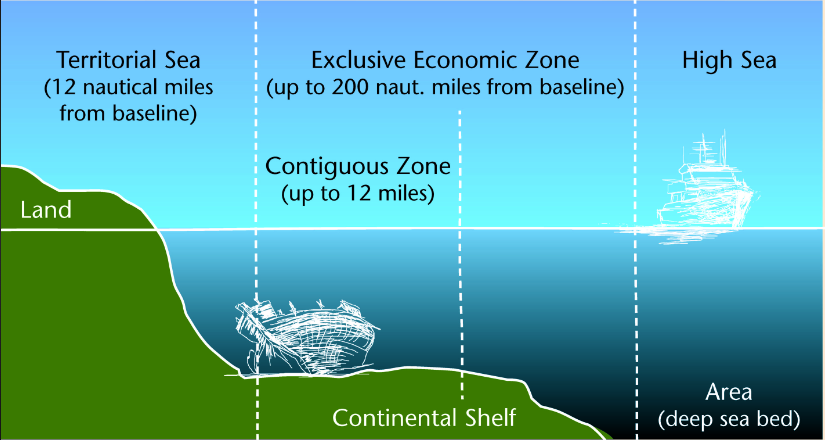
- ✓ Dispute resolution procedures: encouraging peaceful resolution of disputes
Moving ahead toward the dispute resolution procedures under UNCLOS that provide encouraging peaceful resolution of disputes. The approaches offered by these processes include arbitration, conciliation, mediation, negotiation, and adjudication by international courts and tribunals. The best example of this is the Philippines and China case in that case the arbitral panel that heard the Philippines’ South China Sea dispute against China’s historical claim and returned a majority decision favoring the Philippines. Furthermore, this decision demonstrated the value of the UNCLOS framework in settling conflicts involving complex marine matters through the legal system as opposed to resorting to force or acting unilaterally. Consequently, the UNCLOS conflict settlement processes encourage the settlement of disputes peacefully.
- ✓ Preservation of the maritime ecosystem and free navigation
Similarly, the UNCLOS provision supports both the South China Sea’s freedom of navigation and the preservation of the maritime ecosystem. These are vital to preserving the health and accessibility of the world’s seas. UNCLOS specifically addresses the conservation of the marine environment in Part XII, which lays out obligations for states to prevent, reduce, and control pollution from a variety of sources, including land-based activities, seabed activities, and vessel-based pollution. In addition, UNCLOS guarantees freedom of navigation, which permits ships of all states to cross international waters without obstruction, which is essential for commerce and communication on a global scale. So, UNCLOS fosters maritime environment protection and freedom of transition.
China responded to international rulings
- ✓Rejecting the decision
Moving down the ladder, moving towards China’s response to international rulings related to the South China Sea. China is rejecting the decision of international rulings. A significant example is China’s denial of the Permanent Court of Arbitration’s 2016 decision, which held that UNCLOS prohibited China from claiming rights based on the nine-dash line. Moreover, China continues to hold to its position and claim historical claims to much of the South China Sea, even after the arbitral panel ruled in favor of the Philippines. Thus, China has reacted to international judgments by rejecting those against its interests, especially those about the South China Sea.
- ✓Pressuring other nations through diplomatic means and engaging in bilateral relations
Similarly, China has pressured other nations through diplomatic means and engaging in bilateral relations to keep them away from the South China Sea claim. As the biggest trading partner of China, ASEAN nations frequently have to navigate intricate political dynamics to avoid confrontations with China. China is ASEAN’s biggest business partner, hence ASEAN wants no problems with China because of the way China has approached the region. This approach effectively reduces resistance from the area to China’s maritime claims and operations in the South China Sea. Furthermore, this demonstrates China’s skillful use of diplomacy to advance its objectives while maintaining essential economic ties. China has thus used diplomatic pressure and conserved bilateral relations with other nations to discourage them from challenging its South China Sea claim.
- ✓ Increasing military expenditure and presence of the navy
Finally, China has increased military expenditure and the presence of the navy in reaction to international talks and decisions about the South China Sea. Regarding the South China Sea issue, former top Chinese official Dai Bingguo stated that the outcome will be “nothing more than a piece of paper.” China maintains its claims by “showing the flag” and demonstrating its might in the area with routine patrols and scheduled drills in the disputed waters with the People’s Liberation Army (PLA), China Coast Guard, and marine militia. Furthermore, China has also investigated the establishment of an Air Defense Identification Zone (ADIZ) in the South China Sea to boost its military might and ability to oversee and control air movement over the disputed region. Consequently, China has responded to international discussions and choices on the South China Sea by increasing military spending and vessel deployment.
Critical analysis
Critically, the South China Sea conflict is distinct in that it involves several parties and other important countries such as the United States of America. The U.S. has a strong interest in preserving freedom of passage in the area through the help of Taiwan because of its interest. However, China has been using both military and economic might to strengthen its claims, the issue has raised tensions in the area. Building artificial islands and establishing military bases on them, China has been aggressively recovering land in the South China Sea. The idea that China is attempting to take control of the region has scared rivals as well as the international world based on historical claims.
Conclusion
In a nutshell, the 21st century is an economic and Psychological warfare period. The sea is essential for life, climate, food, and international trade. A lifeblood of the world economy is shipping because 90% of world trade is conducted through the sea routes. The South China Sea is important because of its vast natural wealth, important geopolitical impacts, and critical marine routes. However,many country’s territorial and maritime claim the South China Sea, and conflict is going on. Moreover, the United Nations Convention on the Law of the Sea (UNCLOS) plays an important role in the South China Sea dispute by providing a legislative framework for maritime claims, and dispute resolution procedures: encouraging peaceful resolution of disputes, and protecting the marine environment and freedom of navigation. Further, China responded to international rulings by rejecting the decision, pressuring other nations through diplomatic means, engaging in bilateral relations, and increasing military spending and the presence of the navy. Thus, this problem can be resolved with tolerance, bilateral talks, and negotiations.

CSS Solved Past Papers’ Essays
Looking for the last ten years of CSS and PMS Solved Essays and want to know how Sir Kazim’s students write and score the highest marks in the essays’ papers? Then, click on the CSS Solved Essays to start reading them.
CSS Solved Essays
CSS Solved Islamiyat Past Papers
Want to read the last ten years’ Islamiyat Solved Past Papers to learn how to attempt them and to score high? Let’s click on the link below to read them all freely. All past papers have been solved by Pakistan’s top CSS Islamiyat coach having the highest score of their students.
CSS Solved Islamiyat
CSS Solved General Science & Ability Past Papers
Want to read the last ten years’ General Science & Ability Solved Past Papers to learn how to attempt them and to score high? Let’s click on the link below to read them all freely. All past papers have been solved by Pakistan’s top CSS GSA coach having the highest score of their students.
CSS Solved General Science & Ability

